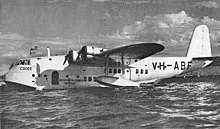S.30 Flying Boat (Total: 14, Canadian: 1, Group 0)
Short S.30 Flying Boat

Short S.23 Cooee of Qantas
The Short Empire was a medium-range four-engined monoplane flying boat, designed and developed by Short Brothers during the 1930s to meet the requirements of the growing commercial airline sector, with a particular emphasis upon its usefulness upon the core routes that served the United Kingdom. It was developed and manufactured in parallel with the Short Sunderland maritime patrol bomber, which went on to serve in the Second World War; a further derivative that was later developed was the piggy-back Short Mayo Composite.
The development of the Short Empire had been heavily influenced by its primary customer, Imperial Airways, who had originally developed the requirements to which it was initially ordered and designed from. Imperial Airways, and its successor, the British Overseas Airways Corporation (BOAC), along with Qantas and TEAL, operated the type in commercial service. Upon entering service, the Empire routinely flew between the British mainland and Australia and the various British colonies in Africa and Asia, typically carrying a combination of passenger and mail cargoes; the Empires were also used on various other routes, such as on the service between Bermuda and New York City.
The Empire also saw military service during the Second World War. The Royal Air Force (RAF), Royal Australian Air Force (RAAF), Royal New Zealand Air Force (RNZAF), and briefly the Royal Canadian Air Force (RCAF) used the type to conduct various military operations, particularly as an airborne platform for anti-submarine patrols and for general transport duties.
The S.30 series was outfitted with four Bristol Perseus XIIc sleeve valve engines in the place of the Pegasus engines; the Perseus engines were more efficient but provided a lower power output of 890 horsepower (660 kW), but the decrease in developed thrust was effectively compensated for via the adoption of smaller diameter nacelles which had resulted in a substantial reduction in drag. It also had a strengthened airframe and used heavier gauge sheeting on the fuselage and wings; while these changes allowed the takeoff weight to be increased to 46,000 pounds (21,000 kg) with a corresponding range of 1,500 miles (2,400 km), the S.30 had broadly the same performance as the preceding S.23 flying boats.
A total of four flying S.30 series flying boats "“ Cabot, Caribou, Clyde and Connemara "“ were equipped with in-flight refuelling equipment and extra fuel tanks in order that they could be used to provide a regular trans-atlantic airmail service. The concept was for the aircraft to take off at lower weights and, once airborne, take on extra fuel to reach an all up weight of 53,000 pounds (24,000 kg), giving the aircraft a range of over 2,500 miles (4,000 km). The extra fuel reduced the payload to 4,270 pounds (1,940 kg) against the 6,250 pounds (2,830 kg) of the standard aeroplane. The refuelling was performed by three converted Handley Page Harrow bombers, one operating out of Ireland and two out of Newfoundland. Wikipedia
S.30 Flying Boat S.30 serial G-AFCZ
s/n GAFCZ
G-AFCZ
Known Units: ;37
last update: 2025-July-06
